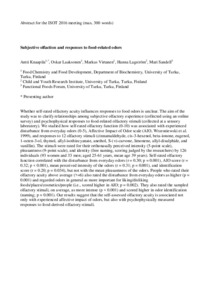Subjective olfaction and responses to food-related odors
Sandell Mari; Knaapila Antti; Lagström Hanna; Laaksonen Oskar; Virtanen Markus
https://urn.fi/URN:NBN:fi-fe2021042716361
Tiivistelmä
Whether self-rated olfactory acuity influences responses to food odors is unclear. The aim of the
study was to clarify relationships among subjective olfactory experience (collected using an online
survey) and psychophysical responses to food-related olfactory stimuli (collected at a sensory
laboratory). We studied how self-rated olfactory function (0-10) was associated with experienced
disturbance from everyday odors (0-5), Affective Impact of Odor scale (AIO, Wrzesniewski et al.
1999), and responses to 12 olfactory stimuli (cinnamaldehyde, cis-3-hexenol, beta-ionone, eugenol,
1-octen-3-ol, thymol, allyl-isothiocyanate, anethol, S-(+)-carvone, limonene, allyl-disulphide, and
vanillin). The stimuli were rated for their orthonasally perceived intensity (5-point scale),
pleasantness (9-point scale), and identity (free naming, scoring judged by the researchers) by 126
individuals (93 women and 33 men; aged 25-61 years, mean age 39 years). Self-rated olfactory
function correlated with the disturbance from everyday odors (r = 0.30; p = 0.001), AIO score (r =
0.32; p < 0.001), mean perceived intensity of the odors (r = 0.31; p = 0.001), and identification
score (r = 0.20; p = 0.034), but not with the mean pleasantness of the odors. People who rated their
olfactory acuity above average (>=6) also rated the disturbance from everyday odors as higher (p =
0.001) and regarded odors in general as more important for liking/disliking
foods/places/cosmetics/people (i.e., scored higher in AIO; p = 0.002). They also rated the sampled
olfactory stimuli, on average, as more intense (p < 0.001) and scored higher in odor identification
(naming; p = 0.001). Our results suggest that the self-assessed olfactory acuity is associated not
only with experienced affective impact of odors, but also with psychophysically measured
responses to food-derived olfactory stimuli.
Kokoelmat
- Rinnakkaistallenteet [19218]
